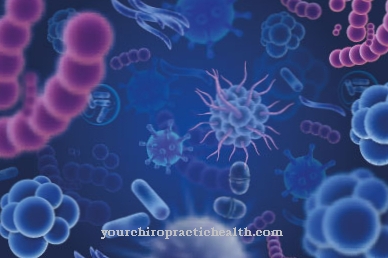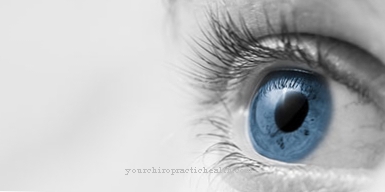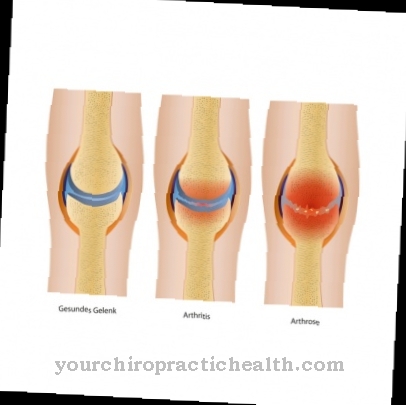For years, patients have been complaining about pain in one or both legs in office hours, which force them to stop after a certain distance. A patient who complains of such pain will certainly be instructed by the doctor to free both legs and lie down on the examination bed. The doctor feels the back of the foot, the areas below the inner ankles, the hollows of the knees and the groin.
causes

© rainbow33 - stock.adobe.com
He will then instruct the patient to lift his legs, use his hands to support his legs under the hollows of his knees and to close his feet roll. In this way it can be determined if and when pain in the Feet or calves appear as observed by the patient walking.
The doctor registers the length of time this foot is rolled using a stopwatch and lets the patient get up immediately as soon as he can no longer roll because of the pain. The feet, which are initially heavily peeled off, usually turn red in spots before the normal color returns.
At the same time we have described the nature of this disease, which is circulatory disorders of the legs and their individual parts, muscles, skin, tendons. The vessels are narrowed by changes in the inner layer and therefore no longer have their normal diameter. The result is that insufficient blood reaches the muscles and other dependent organs.
Diet, especially oxygen supply, is decreased and cramp-like pain occurs. You can check this pain process at any time if you tie off a finger and move it at the same time. A narrowed vessel can also be roughly compared with an old water pipe in which rust, lime or scale has settled; The water flows out of such a pipe only at significantly reduced pressure.
The arterial circulatory disorders occur particularly in men over the age of forty-fifth, in some cases even earlier. The main cause is arteriosclerotic deposits, the formation of which is favored by inflammatory and allergic diseases, chronic foci of pus, for example on the tonsils or teeth, or by metabolic diseases.
We observe these pathological changes more frequently in heavy smokers. This is not surprising when you consider that nicotine is an outright vascular toxin.
A reduced adaptability of the vascular system, which is the result of a lack of physical training and chronic lack of exercise, also has a beneficial effect. The disruption of venous return, especially in overweight people and those with varicose veins, can lead to inflammatory changes in the vicinity of the arteries and affect them.
There is a close relationship between arterial circulatory disorders in the extremities and the inadequate blood flow in the coronary arteries. It is often a disease of the entire arterial vascular system and only in rare cases is it a vascular occlusion caused by blood clots (embolism and thrombosis).
Symptoms, ailments & signs
Impaired blood circulation in the feet and legs is characterized by poor wound healing, tingling, pain and sensory disorders. The symptoms mentioned can have a variety of causes and represent signs of a disease of the feet and legs that requires treatment. But not every symptom that affects the lower extremities is necessarily caused by an arterial circulatory disorder. Stress, temperature fluctuations or psychological factors also play a role in the vascular system contraction.
At the beginning, the changes in the vascular system in the legs are already recognizable, but do not cause any complaints in everyday life and therefore often remain undetected by the patient. The circulatory disorders usually occur in the femoral arteries, but can also affect the arteries of the pelvis or the lower legs.
If the first symptoms occur, such as numbness, feeling cold in the extremities, tingling or pain when walking or climbing stairs, a doctor should definitely clarify the situation in order to rule out various diseases of the blood-forming system.
On this basis, a suitable therapy against the hardening of the arteries can be initiated, since the symptoms, if left untreated, become more and more severe as the disease progresses. In this case, it would ultimately lead to constant pain with movement or load such as "intermittent claudication" in the lower limbs.
Complications
Arterial circulatory disorders in the feet and legs usually progress slowly because the pathological changes in the supplying arteries also slowly change in parallel. As a rule, however, it is a question of deterioration if the disorders are left untreated and the causes are neither recognized nor eliminated. One of the first complications is often sensory deficits.
A kind of numbness develops in the legs and feet, and tactile pain sensations are greatly reduced or completely eliminated. In more advanced stages, complications occur in the form of pain, which is particularly severe under stress, such as the well-known peripheral arterial occlusive disease, which is also known as intermittent claudication. Because of the inadequate supply of tissue in the legs and feet, wound healing is impaired after an injury.
Irreversible tissue death can present itself as a serious complication. In particularly serious cases, in which dead tissue in connection with the irreversibility of adequate blood circulation corresponds, it may even be necessary to amputate the affected limb. Impending poisoning of the entire body, which would be immediately life-threatening, is thus prevented.
Regardless of the treatment of the circulatory disorder, the complications that occur correspond to the severity of the arterial supply bottleneck. However, not all complications that have occurred regress if the threshold for irreversibility has already been exceeded.
When should you go to the doctor?
If numbness or sensory disorders are repeatedly noticed in the limbs, a doctor is recommended. An arterial circulation disorder in the feet and legs also manifests itself as paleness, muscle weakness and pain. If these symptoms are noticed - regardless of whether they appear slowly or suddenly - a doctor must clarify the cause. Although the blood circulation is not always disturbed, the symptoms at least indicate a disease that needs to be diagnosed and, if necessary, treated.
If the underlying disease is not treated, the symptoms will continue to increase and ultimately lead to tissue damage such as the so-called smoker's leg. A medical examination is necessary at the latest when symptoms of paralysis are accompanied by severe pain, which never completely disappears even when you are at rest.
Patients with diabetes or existing arterial disease should speak to their doctor immediately if they have unusual symptoms. If dizziness, chest tightness and sharp pain occur in the right arm, there is an acute danger to life and the emergency services must be contacted. In addition to this, first aid measures must be provided.
Doctors & therapists in your area
Treatment & Therapy
It goes without saying that it is advisable to take effective measures at the first signs to prevent the disease from progressing. After a special examination, the treatment plan is determined. If the disease is already advanced, you can restore the peripheral blood flow with the help of medication or surgery.
To complement and continue clinical treatment, cures are also suitable, with the help of which the bypass circuit existing in all people can be trained and made resilient so that small vessels are enabled to take over the function of the constricted large arteries. However, the artificial vascular replacement often proves to be superior to all these measures.
Long-term success can also be achieved without surgery in those patients who come for treatment early and are willing to undergo long-term treatment with all its consequences for the lifestyle of the individual.
The main thing here is that the patient works at home under the guidance of the doctor and trains his vascular system daily according to a fixed plan. The best workout is exercise. The most favorable loads are: at least twice a day foot roll exercises, which are performed three times in a row to below the pain threshold.
To do this, we lie down relaxed on our back and lift our legs slightly bent. We hold the back of the knees with our hands and move the feet in a circular motion, possibly also the entire lower legs. It is best not to do this exercise on a full stomach.
If it is found to be too strenuous, especially by older people, it is advisable to sit in a comfortable armchair with both hands only around one leg and thus to perform the rolling exercises one after the other. In any case, it is important that you get up after the pain occurs and wait until it has subsided and any discoloration that may have occurred has normalized.
Other effective measures against circulatory disorders are special foot gymnastics, regular walking training, hiking, cycling, jogging and swimming, although the performance limit indicated by the pain must not be exceeded. All exercises must be carried out in such a way that we achieve the best possible blood flow by alternating tension and relaxation.
The exercises mentioned can be supplemented by dry brushing. The linework begins at the bottom of the legs, on the inner sides. The Don't forget the soles of your feet! Brushing is always in the direction of the heart, i.e. arms and legs upwards, until a slight reddening and feeling of warmth occurs.
The following scheme has proven itself: right leg up to the buttocks, left leg up to the buttocks, right arm and right shoulder, left arm and left shoulder, back and hips from buttocks up, stomach circling clockwise, upper body from shoulder to sternum and along the ribs.
Outlook & forecast
The arterial circulation disorders in the feet and legs have a good prognosis. The medical treatment provides various options that lead to the elimination of the disorder. However, it must be taken into account that the disease can be fatal without medical care.
If a thrombus clogs the blood vessels, there is a risk that it will come off and be transported to another location via the bloodstream. There it can obstruct various supply lines and trigger blood congestion. A congestion of the blood causes damage to the vessel walls.
In severe cases, there is a risk of a stroke, which can lead to lifelong impairment or death. If the circulatory disorder in the feet and legs is diagnosed early, however, there is a good chance of a cure.
The vasoconstriction can be removed by the administration of medication or surgery. The patient is symptom-free within a few days or weeks. A normal blood supply takes place and the symptoms are eliminated.
In order that there is no renewed vasoconstriction, the cooperation of the person concerned is important. Adequate exercise, a healthy lifestyle and measures to promote blood circulation should be carried out independently. If the legs are barely moved over a long period of time or if a rigid posture is adopted, the risk of health problems increases.
Alternating baths according to Kneipp
Other measures that promote blood circulation are the temperature-controlled Kneipp alternating casts, which are performed on the healthy leg or on the arms. We start with a pour of about 36 to 38 degrees, finish with a cold pour of about 20 to 24 degrees and finish the pour warm. Then we go to bed.
Only with progressive training and after the symptoms have improved - you feels this in the faster rewarming - another cold pour is connected and then run. Increasing partial baths, also on the healthy leg, or, if both legs are affected, on the arm, as well as increasing hip baths are recommended.
The legs are to be covered with blankets. These baths are generally started at 36 degrees and the temperature is increased in the course of 20 minutes to a maximum of 41 degrees. It is then recommended to rest for at least 30 minutes.
These measures - as simple as they may seem and as easy to implement - have proven beneficial and effective. However, the patient must visit his doctor at regular intervals, who will work out a fixed daily schedule with him and encourage him to do it regularly.
Success in this disease can only be expected through treatment that has been consistently followed for months, perhaps even years, and strict avoidance of all damaging factors. The relief of the symptoms is the reward of consistent treatment and regular vascular training. The person concerned will notice that he can travel longer and longer distances without pain. The ultimate goal, however, is to maintain the efficiency and functionality of the vessels.
Aftercare
If there is an arterial circulation disorder in the feet and legs, a certain follow-up care should be observed. It is important that the doctor's instructions are carefully followed after the diagnosis and therapy. This tells the affected person certain behaviors that alleviate the symptoms as much as possible. In addition, it should be ensured that the so-called support stockings are always worn.
These ensure that the blood is properly distributed in the legs and feet. Adequate hydration should also be important. Drinking a lot is important in order to distribute the blood well in the body. Regular walks in the air and light sporting activities also get the blood circulation going again. If those affected are prescribed medication, they must be taken.
And exactly according to the doctor's instructions. If these things are taken into account in the follow-up care of the circulatory disorder, nothing stands in the way of alleviating the symptoms. However, if this is not adhered to, this can lead to a deterioration in the state of health.
You can do that yourself
In the case of a complete occlusion of vessels, measures that do not involve surgery or medication usually do not help. This also applies in the event that the circulatory disorder is caused by an embolism or an inflammation.
However, those affected by circulatory disorders of the lower extremities can do a lot to slow down the progression of arterial constriction and to promote the formation of new capillaries. If the condition is caused by arteriosclerosis, those affected can often achieve improvement through a healthier everyday life.
Factors that promote arteriosclerosis should be eliminated if possible. Cigarettes and excessive alcohol consumption should be avoided. The same applies to eating large amounts of fat. Instead, a healthy diet that is rich in vitamins, minerals and low in fats should be achieved. Sufficient fluids are also important because the blood flow is improved.
Movement is essential to maintain blood flow in the affected extremities. Walking for at least thirty minutes a day prevents further narrowing of the arteries, is good for your circulation and makes you feel better. Other sports are also suitable. Along with a healthier diet and more exercise, any excess weight should be reduced.


.jpg)
























